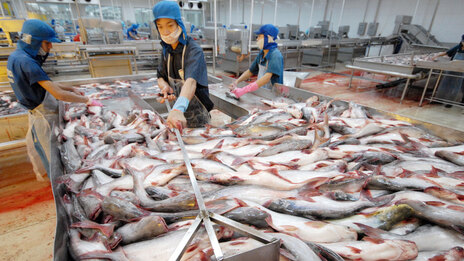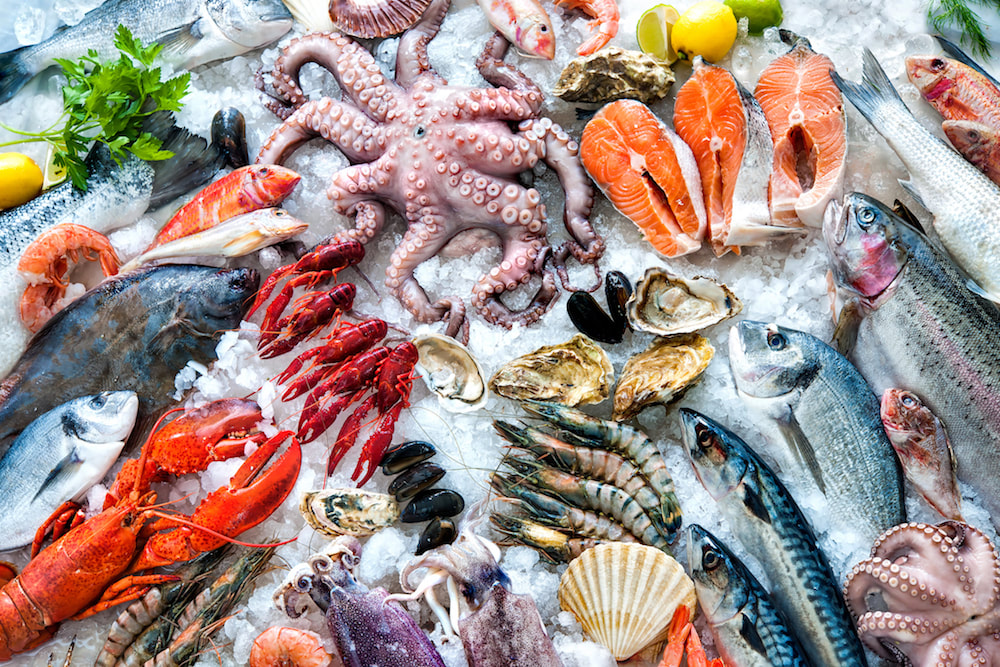 Water used for Processing Fish is a Nutrition Treasure that Can be Used for Many Other Purposes Water used for Processing Fish is a Nutrition Treasure that Can be Used for Many Other Purposes Weekends are probably spent cooking up yummy dishes and non-veg items are a mandatory inclusion during weekends in most of our homes which on other days run on pre-packaged meals, take-away foods or ready-to-eat items. Such a lifestyle promotes increased sugar and fat intake paving way for increase in obesity and diabetes rates. Apart from time and preference, availability and knowledge of nutrition and health too impact our choices. Adapting ourselves to healthy and nutritious foods and redesigning our meal menus is a definite way to tackle the lifestyle problem and pave way for better eating habits. Apart from eating aplenty of fruits, veggies and whole grains we do need a share of certain other nutrients as well to reshape our health and seafood is presently considered as an essential food due to the presence of high-quality proteins, n-3 polyunsaturated fatty acids (PUFAs), minerals, vitamins (vitamin D, B12), iodine, selenium and trace elements-all of which help in promoting brain health and growth. The presence of PUFAs such as eicosapentaenoic acid (EPA) and docosahexaenoic acid (DHA) that are predominantly present in fish oil make way for a healthier body and are often sold as functional foods (those that provide basic nutritional functions and reduce risk of lifestyle-related diseases). Seafoods also improve imbalanced dietary habits and prevent lifestyle-related diseases, all at an economical rate helping to prevent a food crisis in many developing countries. Fish is an abundant source of protein, increases the bioavailability of minerals like zinc and iron and it is no surprise that production has almost doubled in the past couple of decades. There are numerous studies showing that seafood is an excellent source of nutrients, prevents the occurrence of diseases such as CVD and diabetes, helps in child cognitive and visual development and many more too. But sadly, their advantages were not celebrated until about a few decades ago! Gone are the days when our ancestors used to fry fish fresh out of the sea or use vegetables soon after plucking them from the garden. These days, every food undergoes some kind of processing and the degree of processing depends on the product consumed. There are many processed seafood products such as fish cakes, fish pudding, fish au gratin and so on available in the market and it now becomes a necessity to understand the nutrient composition of these products. Norway is a country which shows widespread use of such processed fish products and the study for nutrient composition of seafood that’s elaborated below was conducted in this country. Norwegian Study on Processed Seafood Products Different processed seafood products were selected and 1-7 products from each product type (such as fish cakes) was chosen. All the products were purchased from grocery stores either in chilled or frozen condition between 2015 and 2018. All the products were analyzed as composite samples consisting of three different batches and were homogenized into one composite sample. When there were multiple units in one package only three of them were included from each batch. Each of the composite samples was analyzed for total protein, fat, saturated fatty acids (SFA), monounsaturated fatty acids (MUFA), polyunsaturated fatty acids (PUFA), sum n-3, sum n-6, EPA and DHA. Nutrients including selenium, iron, calcium, zinc, sodium, vitamin A1, vitamin B12 and vitamin D3 were analyzed in 2015 while in 2017 only vitamin D3, iodine, selenium, calcium, iron, zinc, calcium and sodium were analyzed along with fats and fatty acids and in 2018 it was only vitamin D3, iodine, selenium, calcium and sodium besides fatty acids. All samples were freeze-dried, homogenized and pulverized before analyzing: fat was extracted with ethyl acetate, protein was measured by burning material in pure oxygen in a combustion tube, nitrogen was detected with a thermal conductivity detector (TCD), protein content was calculated using a formula (N g/100 g*6.25=protein g/100 g), fat composition was determined by gas chromatography (GC) fatty acids was identified by retention time using standard mixtures of methyl esters, vitamin A was calculated using ultra-performance liquid chromatography (UPLC), retinol content was calculated by external calibration, vitamin D3/D2 was calculated using internal standard, vitamin B12 was released from the sample by extraction, mixed with growth medium and added to the microorganism and its content measured by comparing growth of organism in unknown sample with growth of organism in the known samples, concentration of selenium, zinc and iron was determined by Inductively Coupled Plasma-Mass Spectrometry after wet digestion in a microwave oven and the concentration of calcium and sodium was determined using an external calibration. The research team selected one product of fatty fish, mackerel in tomato sauce and two products of lean fish and fish cakes/burgers to analyze how much each product contributes to total recommended intake (RI) using the Nordic Nutrition Recommendations (NNR): Daily RI values for adults include 250 mg for EPA+DHA, 10 μg for vitamin D, 2.0μg for vitamin B12, 800 μg for vitamin A, 150 μg for iodine, 55 μg for selenium, 8 μg for zinc and 800 μg for calcium. Also, one portions size was equivalent to 40 g of mackerel in tomato sauce, 150 g fish cakes and 275 g fish au gratin. Results showed that:
Seafood-processed Water Enriched with Nutrients Seafood processing required ample water (for boiling shrimps/mussels or filleting/salting/marinating herring) which are then treated as waste once the processing action is complete. But its now shown with evidence that this water contains valuable nutrients that could be used in food or even aquaculture feeds. Its been observed that we need 7000-8000 liters of water for preparing one ton of marinated herring while another 50,000 liters of water is needed to prepare one ton of peeled shrimps or for every three tons of raw shrimps. What we have been missing until now is the fact that the water used for boiling shrimp is readymade stock and the water used for marinating herring contains proteins, peptides, fats and micronutrients that could be used as an ingredient in feed or for growing microalgae. The study from Sweden shows that there are quite a few irresistible nutrients found in these processed waters that are indispensable for health. For example, they contain 7% protein and 2.5% fat. The process water from shrimp contains astaxanthin, a red-colored pigment, and an antioxidant that is used as a dietary supplement. Herring processing until now showed that 15% of herring protein was treated as waste but using a two-step approach the research group was able to recover up to 98% protein and 99% omega 3-rich fats. This process paved the way for a semi-solid biomass and a nutrient-rich liquid. After dehydration, the biomass from shrimp boiling water contained 66% protein and 25% fat. This biomass was used as an ingredient in feed for salmon. Something similar to this has already been implemented in the dairy industry where the residue from preparing cheese, whey, is considered a treasure in sports nutrition as well as in other areas too. References New data on nutrient composition in large selection of commercially available seafood products and its impact on micronutrient intake: https://foodandnutritionresearch.net/index.php/fnr/article/view/3573/9309 Recovering nutrition from seafood process waste: https://foodandnutritionresearch.net/index.php/fnr/article/view/3573/9309 Comments are closed.
|
AVOID FRAUD. EAT SMART+91 7846 800 800
|
- Home
- Written Testimonials
- Consult
- Clinics
- Blogs
-
Diet & Nutrition
- Diabetes Reversal
- IVF IUI not needed for PCOS PCOD Infertility
-
Medical Nutrition
>
-
Disease & Conditions
>
- Infertility | PCOS
- Diabetes Mellitus
- Cholesterol
- Hypothyroid
- Kidney Problems
- Hypertension
- Cardiovascular Diseases
- Liver Diseases
- Gastro intestinal disorder
- Cancer
- Metabolic Disorders
- Orthopedic Disorders
- Eating Disorders
- Dietary Recall
- Weight Record Filled By Clients
- Online Payment Transaction Details
- Online Clients Weight Check Form
- Our Program Package Service Charges
- Weight Record 2017 Clients
- Measurements sent by Clients
- Terms & Conditions Of Payment
- Thanks. Your Form is Submitted
- Video Testimonials
- Lifestyle & Wellness
- Lifestyle & Wellness Blog
- Allergy & Intolerance
- Weight Loss / Gain
- Weight Loss / Slimming Blog
-
Disease & Conditions
>
- Life Cycle Nutrition >
- Sports Nutrition >
- Integrity in Nutrition
- Knowledge Centre
© COPYRIGHT 2022. ALL RIGHTS RESERVED. FRST HEALTHCARE PVT LTD.
Dr. Nafeesa Imteyaz of First Eat Right clinic, is the Best Dietitian Nutritionist in Bangalore. Best Dietitian Nutritionist in Pune. Best Dietitian Nutritionist in Hyderabad. Best Dietitian Nutritionist in Chennai. Best Dietitian Nutritionist in Mumbai. Best Dietitian Nutritionist in Delhi. Best Dietitian Nutritionist in Kolkata.



